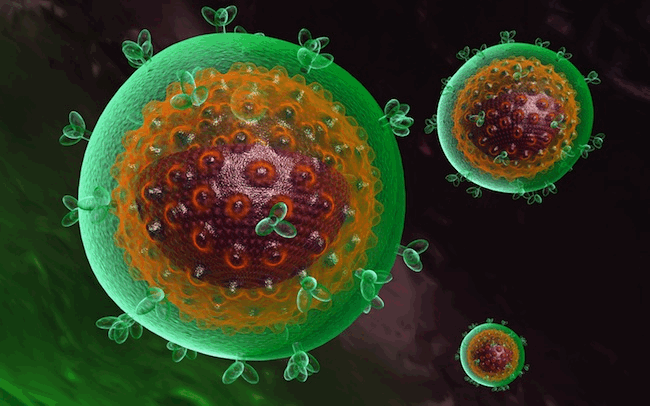 The answer largely depends on the preventative care that you take with your daily living activities.
The answer largely depends on the preventative care that you take with your daily living activities.
Remember that transmission of the Hep C virus is mainly seen through blood to blood contact. Therefore safe practices such as not sharing razors or toothbrushes, having safe sex, and taking careful and mindful precautions not to allow any contact between blood or mucus membranes of yourself and of those in your household you might suspect of being infected, all lower your risk of becoming infected.
 The good news is that today there are new and exciting prescription medications now available in pharmacies that have been known to eradicate the Hep C virus from the body, hence curing the infected liver from the dreaded Hep C virus.
The good news is that today there are new and exciting prescription medications now available in pharmacies that have been known to eradicate the Hep C virus from the body, hence curing the infected liver from the dreaded Hep C virus.
A person can be considered cured when he/she shows a low level of Hep C virus load in the blood after lab testing and these levels are low for a period of at least 6 consecutive months.
Even if a person is considered cured, he/she must regularly test their liver function due to the fact that having had a Hep C infection in the past greatly increases the chances of the appearance of liver cancer, especially if the hepatitis treatment was initiated at a late stage of the disease.
First of all, is important to say that a Hep C viral infection does not easily spread from one person to another. Research has show that the most likely cause of transmission is blood to blood contact, thus the risk of becoming infected without first having contact with infected blood is extremely low.
You can take the following prevention measures to minimize the risk of becoming infected:
- Never share injection needles with anyone.
- If you are at risk of being exposed to another person’s blood or open wound, always use latex gloves.
- Follow safe sex practices that will keep you from becoming in contact with another person’s blood. Consider using condoms.
 Hepatitis caused by the hepatitis C virus is a disease of the liver that can last for a very long without treatment.
Hepatitis caused by the hepatitis C virus is a disease of the liver that can last for a very long without treatment.
The Hep C virus can cause different kinds of damage to a person’s liver that is infected.
In the short term, virus damage caused by the Hep C virus usually produces fibrosis and can sometimes later cause mild scarring of the liver. As time passes with an infected and untreated liver, the risk of cirrhosis, a severe form of liver scarring, increases and causes many debilitating symptoms. Finally, an untreated infected liver may see the appearance of cancer, may result in liver failure, and may unfortunately lead to death.

First of all is important to mention that there are two different stages and types of Hepatitis C virus infection:
Acute stage: The stage, 2 weeks to six months, after the virus has entered the bloodstream. This stage often goes undiagnosed as there are few symptoms and often goes undetected.
Chronic stage: When the liver remains infected with the virus for a long period of time, even for life, with or without symptoms.
Usually, individuals infected with the Hepatitis C virus may experience:
 If you have found yourself or a loved one in one of the following situations recently or in the past, it is advisable to look for professional medical assistance immediately for proper Hep C virus blood screening:
If you have found yourself or a loved one in one of the following situations recently or in the past, it is advisable to look for professional medical assistance immediately for proper Hep C virus blood screening:
- You have shared needles with another person(s), for example during the use of illicit drugs.
- You were transplanted with any organ more than 20 years ago.
- You have had many sexual partners without proper protection, or you are aware of any sexual partners who are or may be suspected of being infected with the Hep C virus.
 The Hepatitis C virus is believed to be exclusively transmitted via the blood. The virus can transmit when the blood of an uninfected person gets in contact with the blood of an infected person.
The Hepatitis C virus is believed to be exclusively transmitted via the blood. The virus can transmit when the blood of an uninfected person gets in contact with the blood of an infected person.
Hep C transmission is most likely to happen when the blood of an infected person comes in direct contact with the blood of an uninfected person such as in blood transfusions improperly screened, the shared use of needles among illicit drug users, accidental needle sticks with infected blood, and direct blood to blood contact with an infected person’s open wound.

The virus can be classified into six different genotypes and each one divided into many subtypes.
A genotype is a classification made based on the RNA (its gene structure) of the Hep C virus.
Usually a person is infected only with one type of virus genotype. Clearly identifying the type of Hep C virus genotype a person is carrying is critical for the doctor to know in advance in order for him or her to prescribe the right course of prescription medication therapy.
 The epatitis C virus, commonly known as the Hep C virus, left unchecked in the bloodstream, often leads to a disease called hepatitis that affects condition and function of the liver.
The epatitis C virus, commonly known as the Hep C virus, left unchecked in the bloodstream, often leads to a disease called hepatitis that affects condition and function of the liver.


